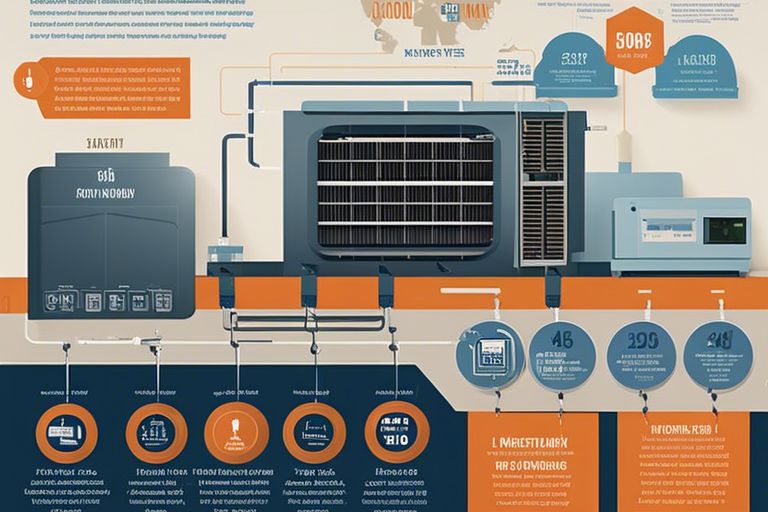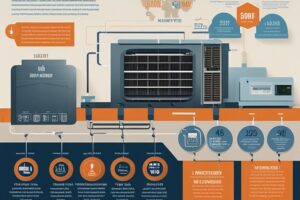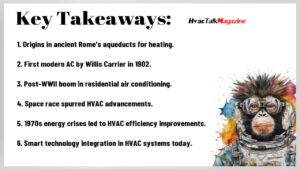What is the history of the modern HVAC system?
As you step into your climate-controlled home or office, have you ever wondered how this luxury became a standard of modern living? The history of the modern HVAC (heating, ventilation, and air conditioning) system is a fascinating tale of innovation and perseverance. From ancient civilizations’ primitive cooling methods to the revolutionary introduction of electric air conditioning in the early 20th century, you’ll discover how pioneers like Willis Carrier and Frederick W. Wolf paved the way for the comfortable indoor environments we enjoy today. Get ready to uncover the transformative milestones that shaped the modern HVAC system, and appreciate the unsung heroes behind this everyday marvel.
What is the history of the modern HVAC system?: Key Takeaways:
The modern HVAC (Heating, Ventilation, and Air Conditioning) system has a rich history that spans over a century. Here are 7 key takeaways about the evolution of HVAC systems:
- The 1800s: Early Beginnings – The concept of HVAC systems dates back to the early 19th century when people used fireplaces and wood stoves for heating. Later, steam-powered heating systems were introduced, marking the beginning of modern HVAC systems.
- The 1900s: Electric Fans and Air Conditioning – The early 20th century saw the introduction of electric fans, which improved ventilation and air circulation. The first electric air conditioning unit was invented in 1902 by Willis Carrier, revolutionizing the industry.
- The 1910s: Central Heating Systems – Central heating systems became popular in the 1910s, allowing for more efficient and cost-effective heating solutions. These systems used boilers, radiators, and pipes to distribute heat throughout buildings.
- 1930s: Refrigeration and Air Conditioning Advancements – The 1930s saw significant advancements in refrigeration technology, leading to more efficient and affordable air conditioning systems. This led to the widespread adoption of AC units in homes and businesses.
- 1950s: Ducted Systems and Heat Pumps – The post-war era saw the introduction of ducted HVAC systems, which used air ducts to distribute heated and cooled air throughout buildings. Heat pumps, which can provide both heating and cooling, also became popular during this time.
- 1970s: Energy Efficiency and Regulations – The 1970s energy crisis led to a focus on energy efficiency in HVAC systems. Governments began implementing regulations and standards for energy consumption, driving innovation in the industry.
- Modern Era: Smart HVAC and Sustainability – Today, HVAC systems are becoming increasingly sophisticated with the integration of smart technology, IoT sensors, and sustainable materials. Modern systems prioritize energy efficiency, indoor air quality, and environmental sustainability.
What is the history of the modern HVAC system?: The Early Beginnings of HVAC
As you investigate the history of modern HVAC systems, you’ll discover that the concept of controlling indoor climate dates back thousands of years.
Ancient Civilizations and Ventilation
Around 2500 BCE, ancient civilizations such as the Egyptians, Greeks, and Romans recognized the importance of ventilation in buildings. They designed structures with large windows, doors, and clerestory openings to allow natural airflow and reduce heat. This primitive form of ventilation was crucial to creating comfortable indoor environments.
The First Mechanical Cooling Systems
Cooling technologies emerged in ancient China around 1000 BCE, where inventors developed manually operated rotary fans to circulate air. These early systems were powered by humans or animals, marking the beginning of mechanical cooling.
Systems like these were not only innovative but also labor-intensive. The rotary fans required constant manual operation, making them impractical for widespread use. However, they paved the way for future advancements in cooling technology. In the centuries that followed, inventors continued experimenting with new materials and designs, gradually improving the efficiency and effectiveness of mechanical cooling systems. Despite their limitations, these early systems demonstrated the potential for technology to transform indoor environments, making them more comfortable and livable.
What is the history of the modern HVAC system?: The Industrial Revolution and HVAC Advancements
It was during the Industrial Revolution that significant advancements were made in the development of modern HVAC systems. As new manufacturing technologies emerged, innovators began to apply these principles to heating and cooling systems.
The Invention of the Centrifugal Chiller
Heating, Ventilation, and Air Conditioning (HVAC) systems took a major leap forward with the invention of the centrifugal chiller in the late 19th century. This innovation allowed for the large-scale cooling of buildings, paving the way for the widespread adoption of air conditioning in the 20th century.
The Development of Air Conditioning Units
Development of air conditioning units became more widespread in the early 20th century, with the introduction of electric-powered compressors and fans. This marked a significant shift from earlier, more cumbersome systems that relied on toxic gases and inefficient designs.
Conditioning the air in large buildings became a reality with the development of these units. You can imagine the impact this had on industries like manufacturing, healthcare, and hospitality, where a comfortable indoor environment was crucial for productivity and customer satisfaction. The ability to control temperature and humidity levels also enabled the construction of taller, more complex buildings that could accommodate more people and activities.
What is the history of the modern HVAC system?: Mid-20th Century Breakthroughs
After World War II, the HVAC industry experienced a surge in innovation, driven by advances in technology and changing consumer needs. This period saw the introduction of new refrigerants, system designs, and components that would transform the industry forever.
The Introduction of Freon and Its Impact
Any discussion of mid-20th century HVAC breakthroughs must include the introduction of Freon, a non-toxic and non-flammable refrigerant that revolutionized the industry. Freon’s stability and safety features made it an ideal replacement for earlier toxic refrigerants, allowing for the widespread adoption of air conditioning systems in homes and buildings.
The Rise of Ductless Mini-Split Systems
Century-old ducted systems were about to get some serious competition with the emergence of ductless mini-split systems. These innovative systems consisted of an outdoor compressor unit connected to multiple indoor air handling units, eliminating the need for bulky and often inefficient ductwork.
With the rise of ductless mini-split systems, you have more flexibility and control over your indoor climate than ever before. These systems allowed for zone cooling and heating, where individual rooms or areas could be cooled or heated independently, reducing energy waste and increasing overall efficiency. This technology also paved the way for the development of more advanced, high-efficiency HVAC systems in the decades to come.
What is the history of the modern HVAC system?? Modern HVAC Systems and Emerging Trends
Not surprisingly, modern HVAC systems have evolved significantly over the years, driven by advancements in technology, changing consumer needs, and growing concerns about energy efficiency and environmental sustainability.
Energy Efficiency and Environmental Concerns
To address the rising demand for eco-friendly solutions, modern HVAC systems are designed to minimize energy consumption and reduce carbon footprint. You’ll notice that many contemporary systems incorporate features like high-efficiency compressors, advanced fan motors, and smart sensors to optimize performance while reducing waste.
What is the history of the modern HVAC system?: The Role of Smart Technology and IoT Integration
An integral part of modern HVAC systems is the integration of smart technology and Internet of Things (IoT) devices. This enables real-time monitoring, automated control, and remote access, allowing you to optimize your system’s performance and energy consumption.
For instance, smart thermostats can learn your schedule and preferences to adjust the temperature accordingly, while IoT-enabled sensors can detect potential issues before they become major problems. This proactive approach can help reduce energy waste, lower your utility bills, and even extend the lifespan of your HVAC system. Moreover, with the rise of voice-controlled assistants, you can now control your HVAC system with simple voice commands, making it easier than ever to stay comfortable and energy-efficient.
What is the history of the modern HVAC system?: Summing up
Summing up, you’ve now traversed the fascinating journey of the modern HVAC system’s evolution. From ancient civilizations’ primitive cooling methods to the innovative breakthroughs of the Industrial Revolution, you’ve witnessed how human ingenuity has transformed the way we control our indoor environments. As you reflect on this narrative, remember that the modern HVAC system is not just a convenience, but a testament to human perseverance and the relentless pursuit of comfort and well-being.
What is the history of the modern HVAC system?: FAQ
Q: When did the concept of HVAC systems first emerge?
A: The concept of heating, ventilation, and air conditioning (HVAC) systems dates back to ancient civilizations. The earliest known evidence of HVAC systems can be traced back to around 2500 BCE in ancient Egypt, where people used simple ventilation systems to circulate air in homes and public buildings. However, the modern concept of HVAC systems as we know it today began to take shape in the late 19th century.
Q: Who is credited with inventing the first modern HVAC system?
A: Willis Carrier, an American inventor and engineer, is credited with inventing the first modern HVAC system in 1902. Carrier developed the first electrical air conditioning unit, which controlled humidity and temperature, and paved the way for the development of modern HVAC systems.
Q: What were some key milestones in the development of modern HVAC systems?
A: Some key milestones in the development of modern HVAC systems include the introduction of electric fans in the 1880s, the development of the first gas furnace in the 1910s, the introduction of air conditioning units for residential use in the 1920s, and the development of heat pumps in the 1950s. These advancements led to more efficient, cost-effective, and environmentally friendly HVAC systems.
Q: How did World War II impact the development of HVAC systems?
A: During World War II, the demand for HVAC systems increased significantly as military bases and defense industries required climate-controlled environments for manufacturing and operations. This led to rapid advancements in HVAC technology, including the development of more efficient and compact systems.
Q: What role did the energy crisis of the 1970s play in shaping the modern HVAC industry?
A: The energy crisis of the 1970s led to a significant shift in the HVAC industry towards more energy-efficient systems. Manufacturers began to develop systems that used less energy, and governments implemented regulations and standards to promote energy efficiency. This led to the development of more environmentally friendly and cost-effective HVAC systems.
Q: How has the modern HVAC industry evolved in recent years?
A: In recent years, the modern HVAC industry has continued to evolve with advancements in technology, changes in consumer behavior, and increasing concerns about climate change. Some key trends include the growth of smart HVAC systems, the increasing adoption of renewable energy sources, and the development of more sustainable and eco-friendly HVAC systems.
Q: What does the future hold for the HVAC industry?
A: The future of the HVAC industry is expected to be shaped by emerging trends such as the Internet of Things (IoT), artificial intelligence, and sustainable energy sources. As concerns about climate change and energy efficiency continue to grow, the industry is likely to shift towards more environmentally friendly and sustainable solutions, including the development of net-zero energy buildings and homes.
Tip of the Day: Best HVAC Systems
Upgrade your home comfort with the best HVAC systems available on Amazon! Discover top-rated units known for their efficiency, reliability, and advanced features.
👉 Shop now on Amazon and find the perfect HVAC system for your needs. Don’t wait—experience superior comfort and energy savings today!
Learn more and join our mailing list for updates.
Follow Us on Google Chrome
To get started, switch to Google Chrome Browser
1. Already on our site
2. Top right, tap the 3 dots
3. Bottom right, tap follow
4. You are done.











